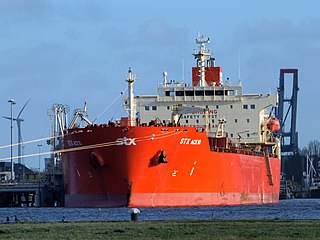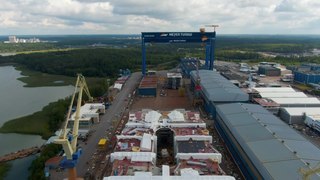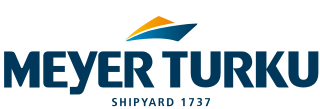
MT Petali is an Aframax crude oil tanker. Formerly known as Mastera for almost two decades and briefly as Mikines in early 2022 and Alma until September 2023, she and her sister ship Tempera were the first ships to utilize the double acting tanker (DAT) concept in which the vessel is designed to travel ahead in open water and astern in severe ice conditions. The icebreaking tanker was built to transport crude oil year-round from the Russian oil terminal in Primorsk to Neste Oil refineries in Porvoo and Naantali.

La Noumbi is a floating production storage and offloading (FPSO) unit operated by Perenco. The vessel, converted from the former Finnish Aframax crude oil tanker Tempera by Keppel Corporation, will replace an older FPSO unit in the Yombo field off the Republic of Congo in 2018.

Azipod is a trademarked azimuth thruster pod design, a marine propulsion unit consisting of a fixed pitch propeller mounted on a steerable gondola ("pod") containing the electric motor driving the propeller, allowing ships to be more maneuverable. They were developed in Finland in the late 1980s jointly by Wärtsilä Marine, Strömberg and the Finnish National Board of Navigation.

Wärtsilä Oyj Abp, trading internationally as Wärtsilä Corporation, is a Finnish company which manufactures and services power sources and other equipment in the marine and energy markets. The core products of Wärtsilä include technologies for the energy sector, including gas, multi-fuel, liquid fuel and biofuel power plants and energy storage systems; and technologies for the marine sector, including cruise ships, ferries, fishing vessels, merchant ships, navy ships, special vessels, tugs, yachts and offshore vessels. Ship design capabilities include ferries, tugs, and vessels for the fishing, merchant, offshore and special segments. Services offerings include online services, underwater services, turbocharger services, and also services for the marine, energy, and oil and gas markets. At the end of December 2022, the company employed 17,500 workers.

A rotor ship is a type of ship designed to use the Magnus effect for propulsion. The ship is propelled, at least in part, by large powered vertical rotors, sometimes known as rotor sails. German engineer Anton Flettner was the first to build a ship that attempted to tap this force for propulsion, and ships using his type of rotor are sometimes known as Flettner ships.

World Kinect Corporation, formerly known as World Fuel Services Corporation, is an energy, commodities, and services company based in Doral, Florida. The company ranked No. 70 in the 2022 Fortune 500 list of the largest United States corporations. WKC focuses on the marketing, trading, and financing of aviation, marine, building, and ground transportation energy commodities and related services. As of 2013, WKC also operates in natural gas and power.

SS Manhattan was an oil tanker constructed at the Fore River Shipyard in Quincy, Massachusetts, that became the first commercial ship to cross the Northwest Passage in 1969. Having been built as an ordinary tanker in 1962, she was refitted for ice navigation during this voyage with an icebreaker bow in 1968–69.

Marine propulsion is the mechanism or system used to generate thrust to move a watercraft through water. While paddles and sails are still used on some smaller boats, most modern ships are propelled by mechanical systems consisting of an electric motor or internal combustion engine driving a propeller, or less frequently, in pump-jets, an impeller. Marine engineering is the discipline concerned with the engineering design process of marine propulsion systems.

An LNG carrier is a tank ship designed for transporting liquefied natural gas (LNG).

Magadan is a Russian icebreaker and the second vessel in a series of three subarctic icebreakers built at Wärtsilä Helsinki shipyard in Finland in 1982–1983. The vessel's sister ships are Mudyug and Dikson.

STX Finland Oy, formerly Aker Yards Oy, was a Finnish shipbuilding company operating three shipyards in Finland, in Turku, Helsinki and Rauma, employing some 2,500 people. It was part of STX Europe, a group of international shipbuilding companies owned by the South Korean STX Corporation.
Aker Arctic Technology Oy is a Finnish engineering company that operates an ice model test basin in Helsinki. In addition to ship model testing, the company offers various design, engineering and consulting services related to icebreakers, other icegoing vessels and arctic offshore projects as well as full scale trials, field expeditions and training for icy conditions. Formerly the arctic research centre of Wärtsilä and later Masa-Yards, Aker Arctic was established on 30 December 2004 as an independent company with Finnish Industry Investment Ltd, ABB and Aker Solutions as its current shareholders.

Marine technology is defined by WEGEMT as "technologies for the safe use, exploitation, protection of, and intervention in, the marine environment." In this regard, according to WEGEMT, the technologies involved in marine technology are the following: naval architecture, marine engineering, ship design, ship building and ship operations; oil and gas exploration, exploitation, and production; hydrodynamics, navigation, sea surface and sub-surface support, underwater technology and engineering; marine resources ; transport logistics and economics; inland, coastal, short sea and deep sea shipping; protection of the marine environment; leisure and safety.

Pan Ocean Co., Ltd. is a shipping company headquartered in Seoul, South Korea. It is an affiliated company of Harim Group.

Otso is a Finnish state-owned icebreaker. Built by Wärtsilä Helsinki shipyard in 1986 to replace the aging Karhu-class icebreakers, she was the first Finnish post-war icebreaker to be built without bow propellers. Otso has an identical sister ship, Kontio, which was delivered in 1987.

A marine LNG engine is a dual fuel engine that uses natural gas and bunker fuel to convert chemical energy in to mechanical energy. Due to natural gas' cleaner burning properties, the use of natural gas in merchant ship propulsion plants is becoming an option for companies in order to comply with IMO and MARPOL environmental regulations. The natural gas is stored in liquid state (LNG) and the boil-off gas is routed to and burned in dual fuel engines. Shipping companies have been cautious when choosing a propulsion system for their fleets. The steam turbine system has been the main choice as the prime mover on LNG carriers over the last several decades. The decades-old system on steam propelled LNG carriers uses BOG. LNG carriers are heavily insulated to keep the LNG at around -160 °C – to keep it liquefied. Despite insulation, the LNG containment area is penetrated by heat which allows for naturally generated boil-off gas (BOG).

Perno shipyard is a shipyard in Turku, southwest Finland, that specialises in building cruise ships, passenger ferries, special vessels and offshore projects. The yard area is 144 hectares and is operated by Meyer Turku Oy with a dry dock 365 metres (1,198 ft) long, 80 metres (260 ft) wide and 10 metres (33 ft) deep. It has the largest bridge crane in the Nordic region with a capacity of 1,200 tonnes and a smaller crane with a capacity of 600 tonnes.

Meyer Turku Oy is a Finnish shipbuilding company located in Turku, Finland Proper. The company is fully owned by German shipbuilder Meyer Werft GmbH. The main products are cruise ships and cruiseferries.
Oy Laivateollisuus Ab (LaTe) was a Finnish shipbuilding company located in Pansio, Turku. The company was founded in 1945 to serve Finnish war reparation industry and focused on wooden ships. The first vessels were a series of schooners, which were followed by other wooden vessels. The last wooden hulls were produced in 1958. The company continued producing wooden gluelam structures in parallel with shipbuilding.

Mudyug is a Russian icebreaker and the lead ship of a series of three subarctic icebreakers built at Wärtsilä Helsinki shipyard in Finland in 1982–1983. The vessel's non-rebuilt sister ships are Magadan and Dikson.
















